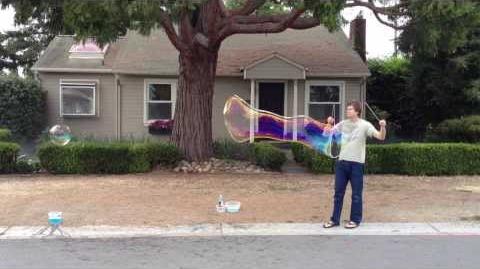According to Edward Spiegel, the soap concentration of bubble juice left in the wand increases as bubbles are made. This phenomenon is especially noticeable with tri-string wands when creating many bubbles from a single dip or when trying to make a second bubble after making a long tube. As multiple bubbles are made from the same dip, a distinct shift in color profile (which indicates film thickness and detergent concentration) will be seen. This is also noticeable when making very long tubes under good conditions (so that changes in color are not due to evaporative thinning). This is especially noticeable when using mixes at or above the Critical Micelle Concentration. The last bubbles will often be transparent or golden.

2013 08 29 High Concentration Bubble Juice
This can also be noticed when blowing bubbles with a plastic wand if the solution is capable of producing many (more than 20) bubbles from a single dip.
Theory[]
Mr. Spiegel proposes that a few factors are at work:
- differences in affinity between the wand material and the solution ingredients: detergent, water, and, possibly, polymers between the wand and the solution.
- micelle migration from surface layer to the solution bulk may possibly be a factor. (This speculation is currently under review. Hopefully, we will have an update soon.)
These factors result in a solution being released by the wand that is somewhat less concentrated than the solution as a whole and results in a more concentrated solution being left behind in the bulk.
The net effect is that water seems to be released very slightly more readily from the wand than the detergent (and possibly the polymers).
The phenomenon can be observed both with wicks and plastic wands and is most pronounced in solutions that have a high surfactant concentration (i.e. one that is greater than the Critical Micelle Concentration). The effect seems to be more pronounced as surfactant concentration increases.
In Practice[]
This phenomenon is most obvious with bubble juice that tends to produce relatively thin films to begin with -- as any further thinning of the film results in a quite obvious shift to transparent or nearly transparent bubbles.
The unequal affinity of wicks for detergent and water explains a few other things that bubbleheads often notice:
- it can take many rinses of bubble wicks to remove the last traces of detergent
- if you squeeze out a wick during a session and move from a low dilution to a high dilution solution, it often takes many more dips to "clear" the previous solution than when moving from high dilution to low dilution
- if you start with a bucketful of bubble juice and make bubbles until the bucket is nearly empty, the juice towards the end of the session behaves as if it has a lot more soap than it started with and needs to be diluted a bit. In fact, it does have more soap in it than it started with!
- this may also explain 'priming' of a wick.
Priming. It has often been observed that a tri-strings performance improves after several bubbles have been made -- even if the wick has been soaking in bubble juice. Mr. Spiegel proposes that the Rule of Increasing Concentration results in the wick becoming more concentrated than the solution as a whole. This may explain why some people report that their wicks work best if they are not rinsed between sessions
More Examples[]

One morning two weeks ago
Watch in Full HD on YouTube!